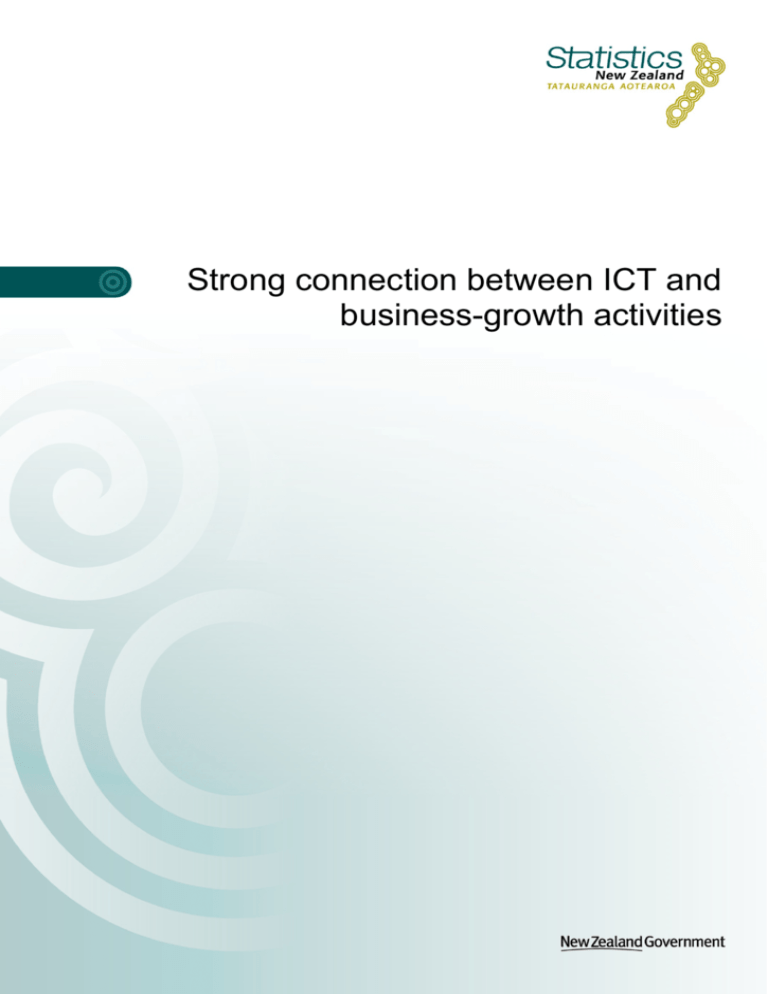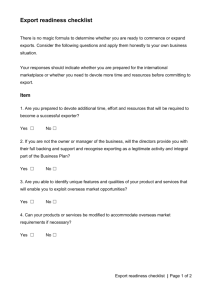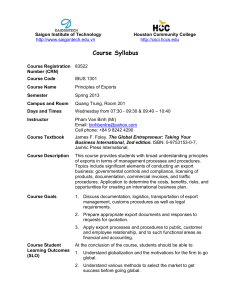Strong connection between ICT and business
advertisement

Strong connection between ICT and business-growth activities Crown copyright © This work is licensed under the Creative Commons Attribution 3.0 New Zealand licence. You are free to copy, distribute, and adapt the work, as long as you attribute the work to Statistics NZ and abide by the other licence terms. Please note you may not use any departmental or governmental emblem, logo, or coat of arms in any way that infringes any provision of the Flags, Emblems, and Names Protection Act 1981. Use the wording 'Statistics New Zealand' in your attribution, not the Statistics NZ logo. Liability While all care and diligence has been used in processing, analysing, and extracting data and information in this publication, Statistics New Zealand gives no warranty it is error free and will not be liable for any loss or damage suffered by the use directly, or indirectly, of the information in this publication. Citation Statistics New Zealand (2013). Strong connection between ICT and business-growth activities. Available from www.stats.govt.nz. ISBN 978-0-478-40859-1 (print) Published in October 2013 by Statistics New Zealand Tatauranga Aotearoa Wellington, New Zealand Contact Dean Manson Wellington: 04 931 4600 Email: info@stats.govt.nz www.stats.govt.nz Contents List of figures ...................................................................................................................... 4 1 Purpose and summary .................................................................................................. 5 2 Businesses that use the Internet to collect sales orders have higher rates of growth activity ............................................................................................................... 6 3 Export rates are higher for those using ICT, across all business sizes ................. 7 4 Use of the Internet to collect sales orders varies between industries .................... 8 5 Export sales are higher for goods-producing firms that have online ordering systems........................................................................................................................... 9 6 Degree of technology change and growth-related activities are connected ........ 11 7 Businesses with more up-to-date core equipment have lower rates of exporting and R&D ........................................................................................................................ 12 8 Conclusion ................................................................................................................... 13 3 List of figures Growth activity done by business, by use of the Internet to collect orders, as at August 2012 ................................................................................................................................. 6 Exporters by business size, by use of the Internet to collect sales orders, last financial year as at August 2012 .................................................................................................... 7 Export rates by industry, by use of the Internet to collect sales orders, last financial year as at August 2012 .................................................................................................... 8 Export sales per business, by use of Internet to collect sales orders, last financial year available at August 2012 ................................................................................................. 9 Growth activities by degree of technology change, last financial year as at August 2012 ............................................................................................................................... 11 Growth activity and the state of core equipment, last financial year as at August 2012 12 4 1 Purpose and summary New Zealand businesses’ information and communication technology (ICT) use and their participation in growth-related activities are strongly linked. For example, businesses that use the Internet to collect sales orders have higher rates of exporting, innovation, and entering new export markets. This article paints a picture of the use of ICT in New Zealand businesses – in particular, the relationship between using ICT and carrying out activities that contribute to business growth. We found that: • Businesses that use the Internet to collect sales orders have higher rates of growth activity. • Export rates are higher for those using ICT, across all business sizes. • Use of the Internet to collect sales orders varies between industries. • Export sales are higher for goods-producing firms that have online ordering systems. • Degree of technology change and growth-related activities are connected. • Businesses with more up-to-date core equipment have lower rates of exporting and R&D. Although we’ve identified a link, this article doesn’t assume that using ICT results in higher growth for businesses. A range of factors could influence the relationships observed in this article. We define ICT as any electronic technology for collecting, processing, storing, or transmitting information in the form of voice, images, or data. These technologies can include computers, software, the Internet, and global positioning systems (GPS). Most of the data comes from our Business Operations Survey (BOS). BOS is a nationwide survey with approximately 6,000 respondents. The survey asks businesses a range of questions on their activities and performance. 5 2 Businesses that use the Internet to collect sales orders have higher rates of growth activity Businesses that use the Internet to collect sales orders are more likely to perform growthrelated activities such as exporting, investing in expansion, and introducing new or improved goods, services, and processes. Figure 1 illustrates the relationship between using the Internet and selected growthrelated activities. These growth indicators were selected due to their importance to increasing national income. For example, exporting products (goods or services) abroad presents opportunities to sell in markets much larger than our domestic market. Figure 1 Growth activity done by business, by use of the Internet to collect orders, as at August 2012 Businesses that use the Internet to collect sales orders are more likely to be involved in exporting. In 2012, 30 percent of businesses that used the Internet to collect orders also exported. This compares with 21 percent that exported but didn’t take online orders. Entering into new export markets such as China is important for growing sales, especially as traditional markets such as Europe continue to be economically unstable. Six percent of businesses that used the Internet to collect sales orders entered new export markets in the previous financial year. In comparison, only two percent of businesses that did not collect sales orders online did the same. Businesses that used the Internet to collect sales orders in 2012 were also more likely to invest in their future expansion, perform research and development, or innovate. 6 3 Export rates are higher for those using ICT, across all business sizes Export rates are higher for those using the Internet to collect sales, when compared with those that do not. Even when comparing businesses of similar size, this remains the case. Figure 2 shows that the rate of exporting increases with business size. However, business size does not explain all the difference between those using the Internet to collect orders and those not. Figure 2 Exporters by business size, by use of the Internet to collect sales orders, last financial year as at August 2012 Although the size of the business explains some of the increase in exports, it doesn’t explain all of it. For all size categories, those using ICT have higher rates of exporting than those not. This suggests factors beyond size differences influence export rates. 7 4 Use of the Internet to collect sales orders varies between industries Businesses’ rates of Internet use and of exporting vary by industry. The wholesale trade industry has the greatest proportion of exporters collecting online sales orders. The health care and social assistance industry has the least. Figure 3 illustrates the percentage of businesses exporting in each industry, and the proportion of businesses in each industry that use the Internet to collect orders. Industries with more businesses and higher rates of exporting contribute more towards the export rate. Some of the difference in export rates for those using the Internet may be because of differences in industry characteristics. Figure 3 Export rates by industry, by use of the Internet to collect sales orders, last financial year as at August 2012 The wholesale trade industry has the highest rate of businesses that export goods and services, as well as the highest proportion of exporters that use the Internet to collect orders. Wholesale traders have an export rate of 53 percent, and almost two-thirds of these collect Internet orders. In comparison, the mining industry has an export rate of 23 percent, of which around one-quarter collect Internet orders. 8 5 Export sales are higher for goods-producing firms that have online ordering systems Goods-producing industries that use the Internet to collect sales orders have the highest reported export sales of any broad industry group1. Figure 4 compares export sales and use of the Internet to collect sales orders across broad industry groups. It shows the average export sales for those businesses that exported in 2012. Figure 4 Export sales per business, by use of Internet to collect sales orders, last financial year available at August 2012 1 The broad industry groupings we’ve used are: primary industries – includes the mining industry and the agricultural, forestry, and fishing industry service industries – includes the wholesale trade; retail trade; accommodation and food services; transport, postal, and warehousing; information media and telecommunications; financial and insurance services; administrative and support services; public administration and safety; education and training; health care and social assistance; arts and recreation services; and ‘other services’ industries goods-producing industries – includes the manufacturing; electricity, gas, water, and waste services; and construction industries. 9 Strong connection between ICT and business-growth activities Export values for goods-producing industries and service industries are higher for those businesses that use the Internet to collect sales orders. This is in contrast to the primary sector, which has higher export values for businesses that don’t collect online sales orders. On average, annual export sales for firms that provide online ordering systems were: • $12.6 million for goods-producing firms • $2.8 million for service exporters • $2.5 million for primary industry firms. For firms that don’t have online ordering systems, average annual export sales values were: • $9.8 million for goods-producing firms • $2.0 million for service exporters. The primary industries show a different picture. The average value of exports for mining businesses (a part of the primary industry) is significantly larger for those that don’t use the Internet than for those that do. This is because mining industry businesses may have established overseas contracts, customers, and networks, therefore do not need to use the Internet to collect orders. 10 6 Degree of technology change and growth-related activities are connected The degree of change in a business’s technology is connected to their involvement in growth-related activities. These activities include introducing new or improved products or processes (innovation), investing in expansion, and performing research and development. Figure 5 Growth activities by degree of technology change, last financial year as at August 2012 In 2012, 82 percent of businesses who said they completely changed their core equipment also innovated. This could mean that when businesses developed or introduced new or improved products, they also had to upgrade their technology. It could also mean that when businesses upgraded their technology, they saw this as introducing a process innovation. Figure 5 suggests businesses that upgraded their technology to a greater degree in the last financial year had higher rates of investment in expansion. Investment in expansion can include purchasing land or assets, developing or introducing new or significantly improved products or processes, or entering new markets. For example, 1 in 2 businesses that completely upgraded their core technology also invested in their expansion in the last financial year. In comparison, only 1 in 8 businesses that didn’t upgrade their core technology invested in expansion. The greater the change in a business’s core equipment technology level, the higher the rate of research and development. For example, 39 percent of businesses that completely changed their core equipment also performed R&D. In comparison, only 4 percent of businesses that didn’t change their core equipment performed R&D. 11 7 Businesses with more up-to-date core equipment have lower rates of exporting and R&D Businesses with more up-to-date core equipment are doing less exporting and R&D. For example, just over 1 in 3 businesses with core equipment more than 10 years old export their products. In comparison, just under one-quarter of businesses whose core equipment was up-to-date export. Figure 6 Growth activity and the state of core equipment, last financial year as at August 2012 The relationship between how up-to-date a business’s technology is and export rates could be explained by industry differences. Service industries have more up-to-date technology but they have low rates of exporting. Conversely, industries with older technology (eg manufacturing and agriculture) have higher rates of exporting. These industries have high export rates naturally, but they require large complicated equipment, which can be expensive to replace. Businesses may simply use the equipment as long as it works – well after new technology has become available. The relationship between R&D rates and core equipment age is due in part to a large proportion of R&D performers coming from the manufacturing industry, which has older core equipment. Around 30 percent of businesses that performed R&D in 2012 were from the manufacturing industry. 12 8 Conclusion In New Zealand, a business’s ICT use and their participation in growth-related activities are strongly linked. Some of the differences between businesses’ growth activities can be explained by the nature of their industry or their size. However, these factors can’t explain everything. ICTs allow buyers and sellers to connect like no other time in history. Geographically isolated New Zealand businesses could benefit from using ICTs like online ordering systems, which can break down barriers to entering new markets. ICT use is positively associated with growth activities – and may play an important role in connecting New Zealand businesses with the rest of the world. 13






